Rabies infection in humans. Rabies in Humans: Symptoms, Transmission, and Prevention
What are the signs and symptoms of rabies in humans. How is rabies transmitted from animals to people. Why is rabies still a major health concern globally. What are the latest prevention and treatment options for rabies. How does rabies affect the nervous system. Can rabies be cured after symptoms appear. When should post-exposure prophylaxis be given for potential rabies exposure.
The Global Impact of Rabies: A Deadly Viral Encephalitis
Rabies continues to be a significant public health threat worldwide, causing an estimated 30,000 to 70,000 deaths annually. This ancient disease, with cases documented as far back as 4000 years ago, primarily affects developing countries where access to preventive measures and post-exposure treatments may be limited.
In contrast, developed nations like the United States have seen a dramatic reduction in rabies cases, with an average of only two deaths per year over the past two decades. This stark difference highlights the effectiveness of widespread vaccination programs and post-exposure prophylaxis in controlling the spread of rabies.

The Deadly Nature of Rabies
For most of human history, a bite from a rabid animal was considered a death sentence. The fear surrounding rabies was so intense that in the past, individuals bitten by potentially rabid animals would sometimes resort to suicide. It wasn’t until Louis Pasteur developed the first rabies vaccine in 1885 that hope emerged for preventing this invariably fatal disease.
Understanding Rabies: Virus Structure and Transmission
Rabies is caused by viruses belonging to the Rhabdoviridae family. These viruses have a distinctive bullet-shaped structure composed of two main parts:
- A viral envelope (structural component)
- A ribonucleocapsid core (functional component)
How is rabies typically transmitted to humans? The most common route of transmission is through the bite of an infected mammal. However, other modes of transmission include:
- Contact of infected saliva with broken skin or mucous membranes
- Inhalation of aerosolized virus particles
- Ingestion of infected material
- Transplacental transmission
- Organ transplantation from infected donors
Animal Vectors of Rabies
In developed countries, which animals are the primary vectors for rabies transmission to humans? While domesticated animals account for only about 10% of rabies cases, wild animals pose a much greater threat. The main culprits include:
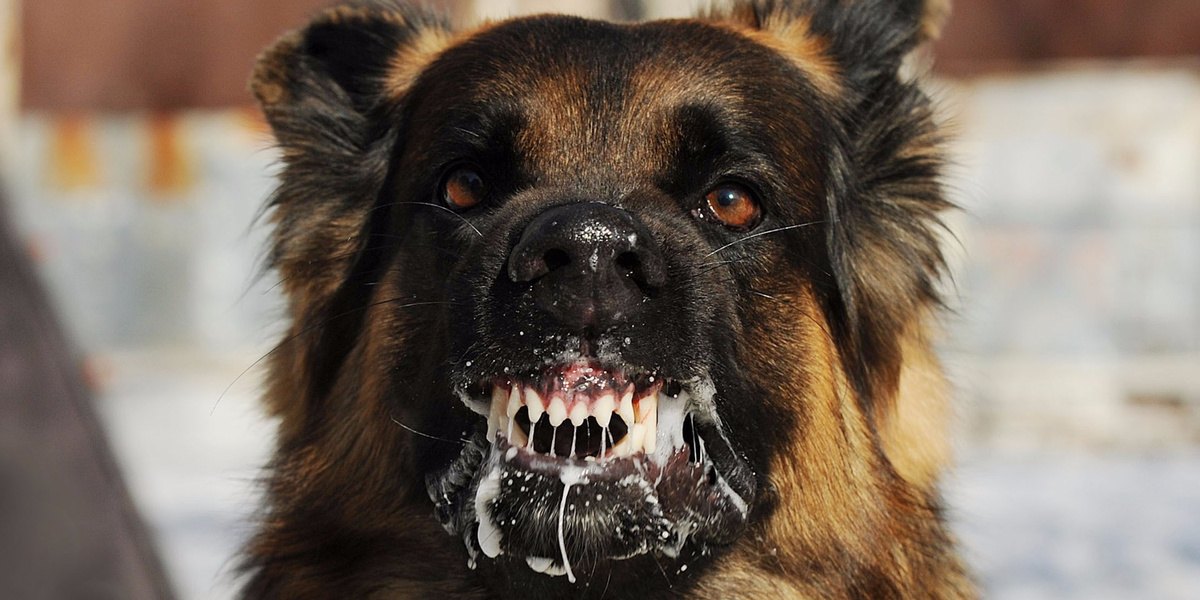
- Bats (the most common source)
- Skunks
- Raccoons
- Foxes
It’s important to note that any mammal can potentially carry rabies. While small rodents and rabbits are generally considered low-risk due to their unlikely survival of an attack by a rabid animal, there have been rare reports of rabies transmission from rats.
The Pathophysiology of Rabies: A Journey Through the Nervous System
How does the rabies virus progress through the body after initial infection? The pathophysiology of rabies involves a complex journey through the nervous system:
- Following transmission, the virus travels through the peripheral nervous system.
- It targets and infects central nerves, leading to encephalomyelitis.
- After reaching the central nervous system (CNS), the virus spreads back to the peripheral nervous system.
- It particularly affects highly innervated areas, such as the salivary glands.
This progression explains many of the characteristic symptoms of rabies, including hypersalivation (the “frothing” often depicted in popular media) and the intense pharyngeal muscle spasms that lead to hydrophobia – a fear of water.
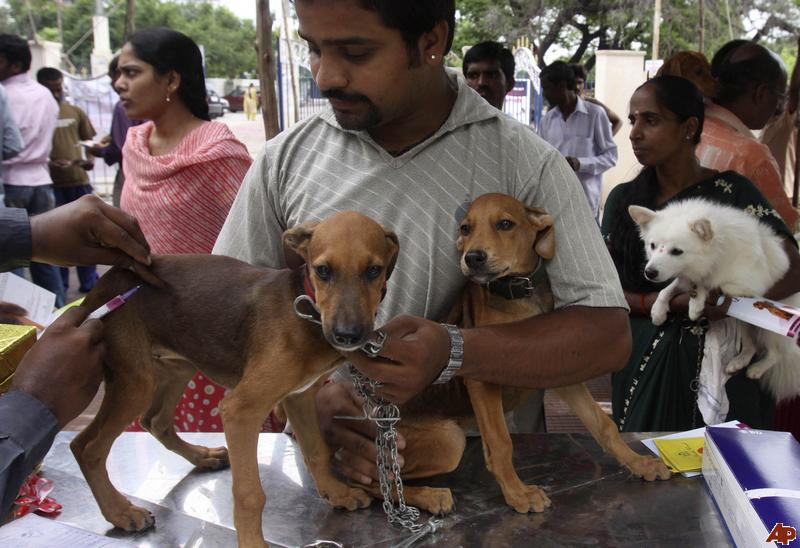
The Variable Incubation Period
How long does it take for rabies symptoms to appear after exposure? The incubation period for rabies can vary dramatically, ranging from two weeks to six years, with an average of a few months. Several factors influence the onset of symptoms:
- Viral load
- Location of exposure
- Severity of the wound
Recognizing the Signs and Symptoms of Rabies
What are the early signs of rabies infection in humans? Initially, rabies presents with nonspecific symptoms that mimic many other viral infections:
- Fever
- Malaise
- Headache
One distinctive early symptom is a tingling sensation at the bite site, which typically occurs within the first few days after exposure.
As the disease progresses, what more severe symptoms emerge? The initial benign symptoms may escalate to:
- Anxiety
- Agitation
- Frank delirium
The Hallmark Symptom: Hydrophobia
Why do rabies patients develop a fear of water? Hydrophobia, a defining symptom of rabies, is characterized by an intense fear or aversion to water. This phenomenon is caused by painful pharyngeal spasms triggered by the mere sight, sound, or attempt to drink water. Despite its name, patients aren’t actually afraid of water itself, but rather the painful spasms associated with swallowing.

The Fatal Progression of Rabies
What happens in the final stages of rabies infection? As the virus continues to spread, it leads to complete failure of the entire nervous system, resulting in rapid death. While infected animals typically succumb to the disease within ten days, the progression in humans can be more prolonged due to medical interventions.
Neurological Impact
How does rabies affect the brain and nervous system? The virus primarily targets the central nervous system, with the brainstem often being the most severely affected area. The exact mechanisms of neurological damage are not fully understood, but they likely involve:
- Inflammatory responses
- Disruption of neurotransmission
- Potential induction of neuronal apoptosis (programmed cell death)
Prevention and Treatment: The Critical Role of Post-Exposure Prophylaxis
Can rabies be prevented after potential exposure? Yes, timely administration of post-exposure prophylaxis (PEP) is highly effective in preventing rabies. This treatment consists of:
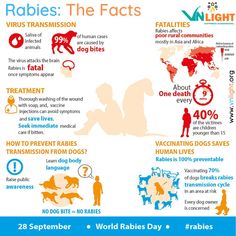
- Rabies immunoglobulin: Provides immediate passive immunity
- Rabies vaccine: Stimulates active immunity
When should post-exposure prophylaxis be given? PEP should be administered as soon as possible after a potential exposure, ideally within the first 24 hours. However, since the incubation period can be quite long, PEP may still be effective even if started days or weeks after the exposure.
The Importance of Wound Care
What is the first step in managing a potential rabies exposure? Immediate and thorough cleansing of the wound is crucial. This should involve:
- Washing the wound with soap and water for at least 15 minutes
- Applying an antiseptic solution if available
- Seeking medical attention promptly
Global Efforts to Eliminate Rabies
What strategies are being employed to reduce rabies cases worldwide? The World Health Organization (WHO) and other global health bodies are working towards the goal of zero human deaths from dog-mediated rabies by 2030. Key strategies include:
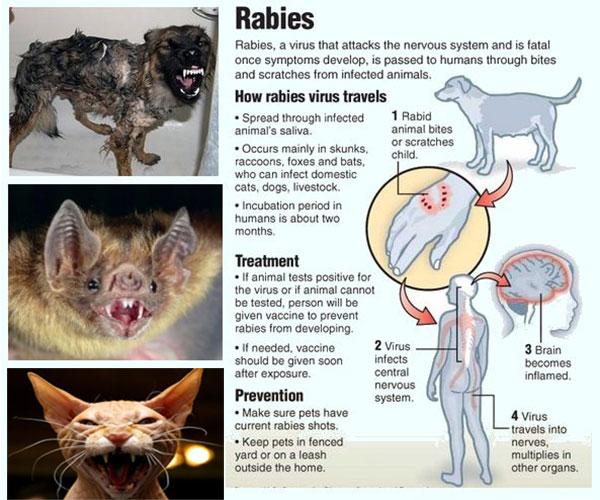
- Mass vaccination of dogs in endemic areas
- Improving access to post-exposure prophylaxis
- Enhancing surveillance and reporting systems
- Educating communities about rabies prevention
Challenges in Rabies Elimination
What obstacles hinder global rabies elimination efforts? Several factors complicate the fight against rabies:
- Limited resources in developing countries
- Lack of political prioritization in some regions
- Difficulties in reaching remote or conflict-affected areas
- The presence of wildlife reservoirs
Despite these challenges, significant progress has been made in reducing human rabies cases, particularly in regions where comprehensive control programs have been implemented.
Innovative Approaches in Rabies Research and Treatment
What new developments are emerging in the field of rabies prevention and treatment? Researchers are exploring several promising avenues:
- Development of more effective and thermostable vaccines
- Investigation of novel antiviral therapies
- Exploration of immunomodulatory approaches to enhance treatment efficacy
- Improvements in rapid diagnostic techniques
The Milwaukee Protocol: A Controversial Approach
Is there any hope for treating rabies after symptoms appear? While rabies has traditionally been considered 100% fatal once symptoms develop, a controversial treatment known as the Milwaukee Protocol has shown limited success in a handful of cases. This approach involves inducing a coma and administering antiviral drugs. However, its effectiveness remains highly debated in the medical community, and prevention through vaccination and post-exposure prophylaxis remains the primary focus of rabies control efforts.

The Role of Public Health and Education in Rabies Control
How can public awareness contribute to rabies prevention? Education plays a crucial role in reducing rabies cases. Key messages include:
- The importance of vaccinating pets
- Avoiding contact with unfamiliar animals, especially wildlife
- Recognizing potential exposure situations
- The critical nature of seeking immediate medical attention after potential exposure
One Health Approach to Rabies Control
Why is a multidisciplinary approach essential in combating rabies? The One Health concept, which recognizes the interconnectedness of human, animal, and environmental health, is particularly relevant to rabies control. This approach involves collaboration between:
- Veterinarians
- Medical professionals
- Public health officials
- Environmental scientists
- Policymakers
By addressing rabies from multiple angles – including animal vaccination, human prevention, and ecosystem management – the One Health approach offers a comprehensive strategy for reducing the global burden of this deadly disease.

Rabies – StatPearls – NCBI Bookshelf
Continuing Education Activity
Rabies causes viral encephalitis which kills up to 70000 people/year worldwide. Infected animal saliva transmits viral encephalitis to humans. Rabies is one of the oldest known diseases in history with cases dating back to 4000 years ago. For most of human history, a bite from a rabid animal was uniformly fatal. In the past, people were so scared of rabies that after being bitten by a potentially rabid animal, many would commit suicide. This activity describes the pathophysiology of rabies and stresses the importance of an interprofessional team in its management.
Objectives:
Identify the etiology of rabies.
Review the pathophysiology of rabies.
Outline the treatment and management options available for rabies.
Describe interprofessional team strategies for improving care and outcomes in patients with rabies.
Access free multiple choice questions on this topic.
Introduction
Rabies causes viral encephalitis which kills up to 70,000 people/year worldwide. Infected animal saliva transmits viral encephalitis to humans. Rabies is one of the oldest known diseases in history with cases dating back to 4000 years ago. For most of human history, a bite from a rabid animal was uniformly fatal. In the past, people were so scared of rabies that after being bitten by a potentially rabid animal, many would commit suicide. Pasteur’s rabies vaccine from 1885 has led to such intense prophylaxis in developed countries, that in the United States, for example, there have only been about two rabies deaths per year for the past two decades; less developed countries are not so lucky.[1][2][3]
Etiology
The Rhabdoviridae family of viruses that are bullet-shaped and composed of two parts cause rabies. The first part is considered more structural and is a viral envelope while the second part is more functional and contains the ribonucleocapsid core.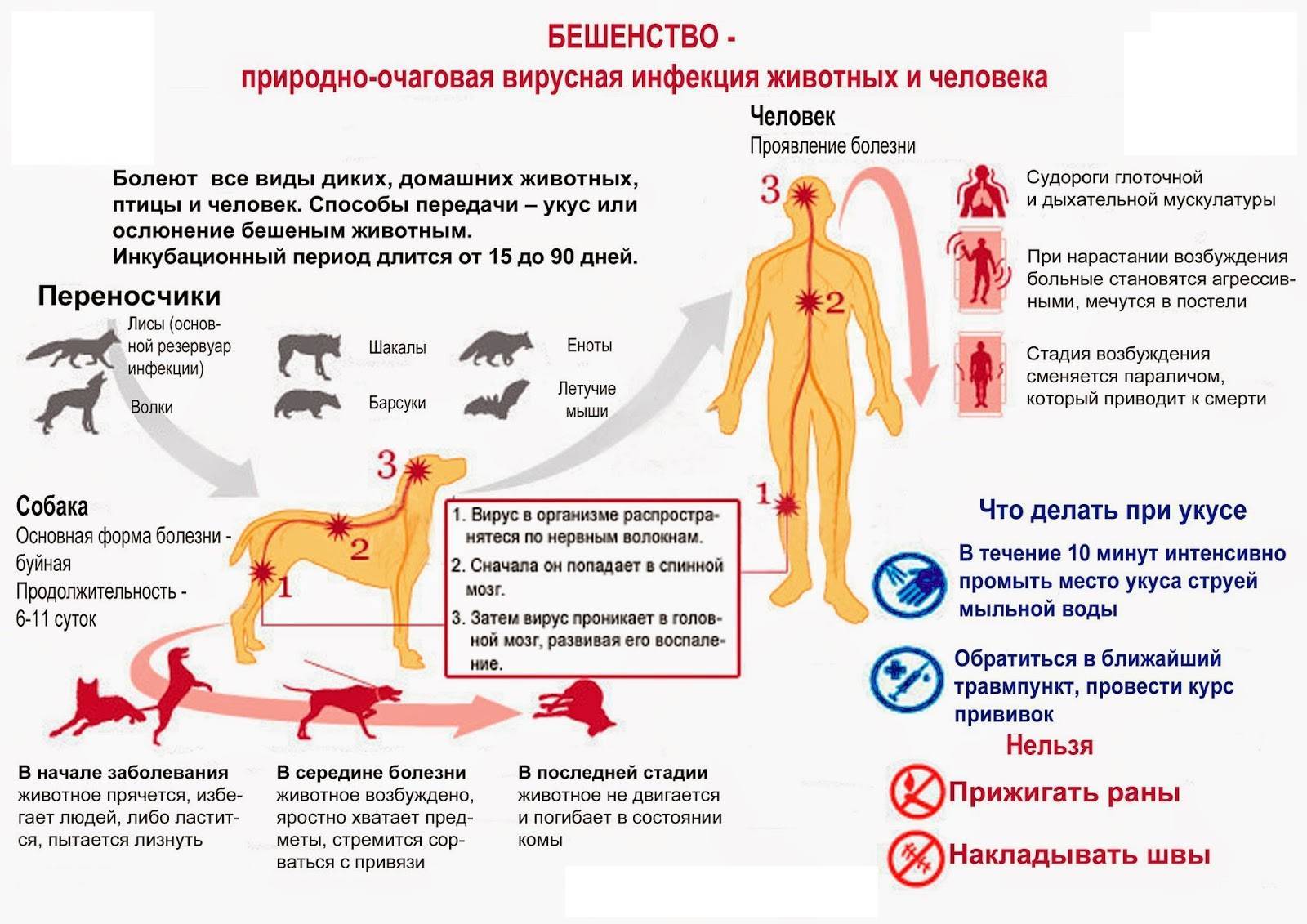 The virus is most commonly spread through the bite of an infected mammal, including domestic and wild ones, but transmission can occur from saliva through broken skin or mucous membranes. Other routes of infection include inhalation of the virus in an aerosolized form, ingestion, transplacentally, and even through organ transplants.[4][5]
The virus is most commonly spread through the bite of an infected mammal, including domestic and wild ones, but transmission can occur from saliva through broken skin or mucous membranes. Other routes of infection include inhalation of the virus in an aerosolized form, ingestion, transplacentally, and even through organ transplants.[4][5]
Epidemiology
Researchers estimate that 30,000 to 70,000 deaths are attributable to rabies each year, with less developed countries affected more. In the United States, there are few human cases reported, though that may be due to the widespread use of post-exposure prophylaxis and the prevention programs in place. In developed countries, domesticated animals have only been responsible for about 10% of cases of rabies transmission, while wild animals such as skunks, raccoons, foxes, and especially bats are responsible for the rest of the cases. Any mammal may carry rabies, and so while small rodents and the rabbit family usually are considered safe as they are not expected to survive an inoculating wound from a rabid animal, there have been anecdotal reports of rabies caused by transmission from rats. As animal carriers vary by region, it is important to know your region’s carriers to help determine who may need prophylaxis.[6][7]
As animal carriers vary by region, it is important to know your region’s carriers to help determine who may need prophylaxis.[6][7]
Pathophysiology
Following viral transmission, the rhabdovirus travels through the peripheral nervous system targeting the central nerves, which then leads to encephalomyelitis. In humans, the first symptoms seem like any other nonspecific viral syndrome (fever, malaise, headache). These benign symptoms may then progress to anxiety, then to agitation, and then to frank delirium. One very consistent symptom after a rabid bite is tingling at the bite site within the first few days. Interestingly enough, after the virus has spread from peripheral nerves to the central nervous system (CNS), it then travels back to the peripheral nervous system, particularly affecting highly innervated areas (e.g., salivary glands). The “frothing” as portrayed in the movies Cujo and Old Yeller, is due to hypersalivation, and victims can suffer from intense pharyngeal muscle spasm at the mere sight, taste, or sound of water. This is called “hydrophobia.” Eventually, the virus progresses to complete failure of the entire nervous system which causes a quick death. While animals tend to die within ten days, the incubation period following inoculation can last two weeks to six years, averaging a few months. Determining factors for the time of onset include the viral load, location of exposure, and severity of the wound. The virus ultimately affects the central nervous system, usually affecting the brainstem more severely. The toxic effects occur through an inflammatory response, with functional changes not completely understood. Ultimately the virus is suspected to affect neurotransmission, and apoptosis may occur through virus-dependent and cell-dependent routes. Once clinical features are seen, rabies is universally fatal.[8]
This is called “hydrophobia.” Eventually, the virus progresses to complete failure of the entire nervous system which causes a quick death. While animals tend to die within ten days, the incubation period following inoculation can last two weeks to six years, averaging a few months. Determining factors for the time of onset include the viral load, location of exposure, and severity of the wound. The virus ultimately affects the central nervous system, usually affecting the brainstem more severely. The toxic effects occur through an inflammatory response, with functional changes not completely understood. Ultimately the virus is suspected to affect neurotransmission, and apoptosis may occur through virus-dependent and cell-dependent routes. Once clinical features are seen, rabies is universally fatal.[8]
Histopathology
Autopsy studies have revealed that the brain usually is swollen, congested, and has an acute inflammatory process. In most cases, the presence of neuronal death is rare. Immunochemical staining will reveal deposits of the virion in the nerve cytoplasm. Negri bodies are often seen on light microscopy but only in about two-thirds of cases.
Immunochemical staining will reveal deposits of the virion in the nerve cytoplasm. Negri bodies are often seen on light microscopy but only in about two-thirds of cases.
History and Physical
The history of a rabies-infected patient may be simple and straightforward with a known bite from a rabid animal. Unfortunately, it may be challenging to obtain a history pointing towards rabies due to the potential for a long incubation period and multiple potential transmission methods.
There are five stages of rabies following inoculation: incubation; prodrome; acute neurologic illness; coma; and death.
Incubation is the period defined as an inoculation to the first onset of symptoms and can range from days to years.
The prodrome phase includes nonspecific symptoms similar to flu-like illnesses with gastrointestinal symptoms, myalgias, and fevers being some of the possible symptoms.
The third stage of rabies is when neurologic symptoms occur. These are classified into one of three categories: encephalitic (also considered “furious”), paralytic (also considered “dumb”), and a rare non-classic form.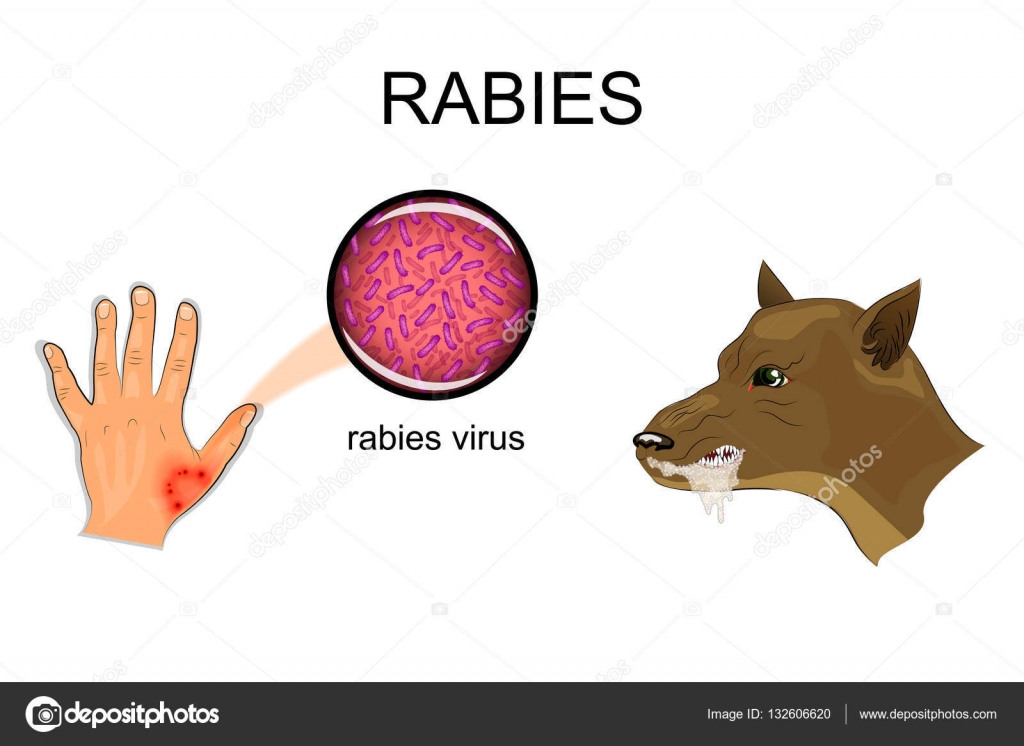
The encephalitic form is most common and presents in approximately 85% of cases. These patients may exhibit hydrophobia or aerophobia, which is when spasms develop as a result of stimuli such as swallowing liquids (hydrophobia). Agitation and changes in mentation can occur during the encephalitic form, with the potential for autonomic dysfunction, increased deep tendon reflexes, nuchal rigidity, and finding positive Babinski sign. Other examination findings outside the nervous system can include tachycardia, tachypnea, and fever. This progresses rapidly to hyperactivity.
The paralytic form of rabies is less common and noted to occur less than 20% of the time. These patients may be confused with Guillain-Barre syndrome as the classically associated hydrophobia, and irritability is not seen. Weakness is a hallmark, though patients may also have altered mentation, ongoing fevers, and bladder dysfunction.
The final form of rabies is considered non-classic and is rare, generally associated with seizures and more profound motor and sensory symptoms.

Stage 4 of rabies is the coma stage and usually begins within ten days of stage 3. Patients may have ongoing hydrophobia, develop prolonged apnea periods, and have flaccid paralysis.
Following the onset of stage 4, without supportive care due to cardiopulmonary failure, most patients experience death within two to three days. Even with supportive therapy, virtually zero patients survive rabies.
Evaluation
Without a clear-cut rabid bite history, rabies is often a diagnosis of exclusion. In early stages, it may manifest similar to influenza, Coxsackie, enterovirus, and herpes. In later stages, rabies may present similarly to delirium tremens, tetanus, botulism, diphtheria, tick-borne diseases, and Guillain Barre. It is common for physicians to check CBC, electrolytes, cultures, CT, chest x-ray, and MRI and still, have no idea that rabies is the culprit. Unless isolated in a rabies-specific viral culture, detected by polymerase chain reaction (PCR) in saliva, found to have positive antibody titer, or isolated in cerebrospinal fluid (CSF), the diagnosis may continue to be elusive until too late.
Rabies can be diagnosed through multiple routes using CSF, blood, saliva, tears, and tissue biopsies (neck, immunofluorescent stain). CSF analysis can show a pleocytosis and may allow isolation of the virus. The Centers for Disease Control and Prevention notes that no single test is enough to rule in or out rabies. Ultimately, a high level of suspicion is required in developed countries due to the rarity of the disease.[9][10][11]
If the biting animal can be euthanized and tested then that may prevent the need to administer post-exposure prophylaxis. Public health may be able to facilitate the testing of the animal.
Treatment / Management
There is no effective treatment for rabies. Prevention is the mainstay of treatment including programs involving domestic animal vaccination, education, and monitoring.[12][13][14]
Wound care is the first step in the treatment of any individual with a feared rabies exposure. Appropriate wound care alone has been noted to be almost 100% effective if initiated within three hours of inoculation.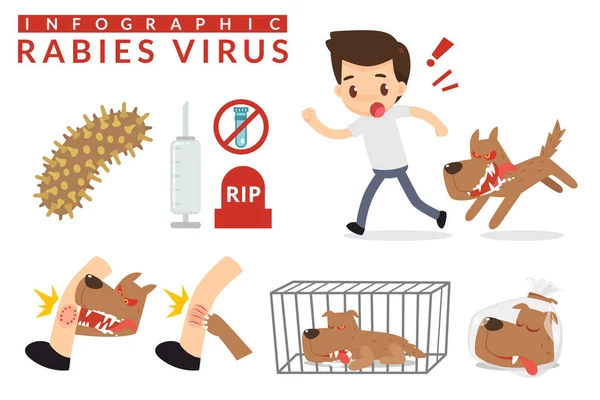 Recommendations include scrubbing the wound and surrounding area with soap and water (solutions include 20% soap solution, povidone, and alcohol solutions), and swabbing deeply for puncture wounds, with irrigation. After cleaning the wound thoroughly the application of a virucidal agent such as benzalkonium chloride or povidone-iodine is recommended.
Recommendations include scrubbing the wound and surrounding area with soap and water (solutions include 20% soap solution, povidone, and alcohol solutions), and swabbing deeply for puncture wounds, with irrigation. After cleaning the wound thoroughly the application of a virucidal agent such as benzalkonium chloride or povidone-iodine is recommended.
In the United States, when a bite is known to be from a bat, skunk, raccoon, or fox, treat immediately with rabies vaccine and rabies immune globulin. For all other bites, consult the public health department. Outside of the United States, a dog bite should be treated immediately with vaccine and rabies immune globulin.
Treatment is then initiated based on if the patient was previously immunized or not. For patients with previous immunization, a typical treatment may be with a human diploid cell vaccine or purified chick embryo cell vaccine at a dose of 1 mL injected intramuscularly on the day it occurs (day 0) and on day 3.
If the patient has not been previously immunized, the treatment still involves dosing with one of the two vaccines listed above with 1 mL given intramuscularly on days 0, 3, 7, and 14 (and on day 28 if the individual is immunosuppressed). The dose of the vaccine should be given at a site distant from where the second part of treatment (human rabies immune globulin or HRIG) is given. These unimmunized patients are treated with human rabies immune globulin as well at a dose of 20 IU/kg, with a preference to infiltrate as much of that dose around the wound as possible. Any remaining dose of human rabies immune globulin not infiltrated into the wound is then given intramuscularly, and as mentioned above is given at a site distant from the vaccine.
The dose of the vaccine should be given at a site distant from where the second part of treatment (human rabies immune globulin or HRIG) is given. These unimmunized patients are treated with human rabies immune globulin as well at a dose of 20 IU/kg, with a preference to infiltrate as much of that dose around the wound as possible. Any remaining dose of human rabies immune globulin not infiltrated into the wound is then given intramuscularly, and as mentioned above is given at a site distant from the vaccine.
Recently, recommendations have been updated in the United States, and since bats are by far the major source of rabies here, any person who awakens from sleep and finds a bat in the room should be urgently immunized.
Differential Diagnosis
Psychosis
Seizures
Poisoning with belladonna alkaloids
Stroke
Jacob Creutzfeldt disease
Brain tumor
Encephalitis
Tetanus
Complications
Consultations
Neurologist
Infectious disease
Neurosurgeon
Public health
Enhancing Healthcare Team Outcomes
When a diagnosis of rabies is made, an interprofessional team is necessary as the repercussions of this infection go way beyond the acute infection.
Blood transfusions have not been documented to transmit rabies, though it has been suggested to hold donation for one year following exposure prophylaxis. If no exposure was noted, but vaccination occurred there is a recommendation to wait four weeks.
Since rabies is entrenched within the native animal population in the United States, there will continue to be human exposure to this fatal disease. Public health officials take a very active role in preventing rabies, both before exposures as well as after possible exposures.
Animal control has to be notified to determine if the domestic animals require vaccination. In addition, vaccination of workers who may be exposed to rabies may also be necessary.
Patients need to be educated on avoiding contact with wildlife, and if ever bitten, the area should be thoroughly washed to lower the risk of rabies transmission. All dead and sick animals should be handled with heavy gloves. If bitten by a wild animal, one should seek immediate medical assistance.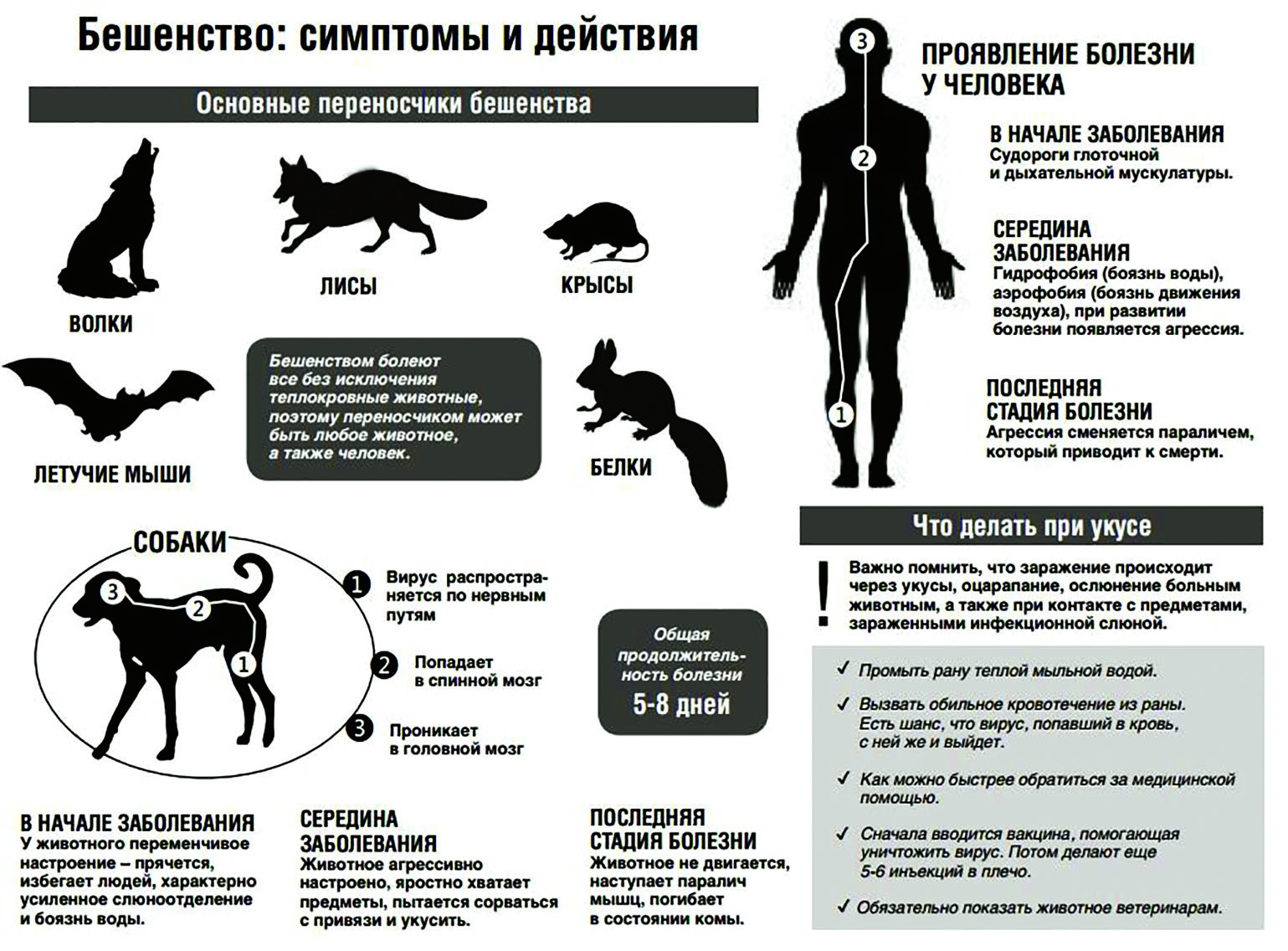 [15][16][17](Level V)
[15][16][17](Level V)
Outcomes
For those who develop symptoms of rabies, survival is rare. Only a handful of survivors exist in the USA after acquiring rabies. For those without symptoms but with rabies vaccine prophylaxis, survival is assured. Individuals who are bitten by a rabid animal need the rabies vaccine and immunoglobulin ASAP for survival- once the symptoms appear, death is inevitable.[18][19] [Level 5]
Review Questions
Access free multiple choice questions on this topic.
Comment on this article.
References
- 1.
Bedeković T, Lohman Janković I, Šimić I, Krešić N, Lojkić I, Sučec I, Robardet E, Cliquet F. Control and elimination of rabies in Croatia. PLoS One. 2018;13(9):e0204115. [PMC free article: PMC6147469] [PubMed: 30235274]
- 2.
Pedersen K, Schmit BS, DeLiberto TJ, Suckow JR, Davis AJ, Slate D, Chipman RB, Hale RL, Gilbert AT. Raccoon (Procyon lotor) biomarker and rabies antibody response to varying oral rabies vaccine bait densities in northwestern Pennsylvania.
 Heliyon. 2018 Sep;4(9):e00754. [PMC free article: PMC6129686] [PubMed: 30211329]
Heliyon. 2018 Sep;4(9):e00754. [PMC free article: PMC6129686] [PubMed: 30211329]- 3.
Sambo M, Hampson K, Changalucha J, Cleaveland S, Lembo T, Lushasi K, Mbunda E, Mtema Z, Sikana L, Johnson PCD. Estimating the Size of Dog Populations in Tanzania to Inform Rabies Control. Vet Sci. 2018 Sep 07;5(3) [PMC free article: PMC6164483] [PubMed: 30205470]
- 4.
Yang DK, Kim HH, Cho IS. Strategies to maintain Korea’s animal rabies non-occurrence status. Clin Exp Vaccine Res. 2018 Jul;7(2):87-92. [PMC free article: PMC6082677] [PubMed: 30112347]
- 5.
Lu XX, Zhu WY, Wu GZ. Rabies virus transmission via solid organs or tissue allotransplantation. Infect Dis Poverty. 2018 Aug 15;7(1):82. [PMC free article: PMC6092857] [PubMed: 30107857]
- 6.
Yahiaoui F, Kardjadj M, Laidoudi Y, Medkour H, Ben-Mahdi MH. The epidemiology of dog rabies in Algeria: Retrospective national study of dog rabies cases, determination of vaccination coverage and immune response evaluation of three commercial used vaccines.
 Prev Vet Med. 2018 Oct 01;158:65-70. [PubMed: 30220397]
Prev Vet Med. 2018 Oct 01;158:65-70. [PubMed: 30220397]- 7.
Broban A, Tejiokem MC, Tiembré I, Druelles S, L’Azou M. Bolstering human rabies surveillance in Africa is crucial to eliminating canine-mediated rabies. PLoS Negl Trop Dis. 2018 Sep;12(9):e0006367. [PMC free article: PMC6126826] [PubMed: 30188896]
- 8.
Ugolini G, Hemachudha T. Rabies: changing prophylaxis and new insights in pathophysiology. Curr Opin Infect Dis. 2018 Feb;31(1):93-101. [PubMed: 29293476]
- 9.
Hennenfent AK, Iyengar P, Davies-Cole J. Assessing rabies knowledge gaps in human and animal healthcare professionals practicing in Washington, DC-A one health approach. Zoonoses Public Health. 2018 Dec;65(8):947-956. [PubMed: 30099849]
- 10.
Amparo ACB, Jayme SI, Roces MCR, Quizon MCL, Mercado MLL, Dela Cruz MPZ, Licuan DA, Villalon EES, Baquilod MS, Hernandez LM, Taylor LH, Nel LH. The evaluation of Animal Bite Treatment Centers in the Philippines from a patient perspective.
 PLoS One. 2018;13(7):e0200873. [PMC free article: PMC6062032] [PubMed: 30048466]
PLoS One. 2018;13(7):e0200873. [PMC free article: PMC6062032] [PubMed: 30048466]- 11.
Robardet E, Rieder J, Barrat J, Cliquet F. Reconsidering Oral Rabies Vaccine Bait Uptake Evaluation at Population Level: A Simple, Noninvasive, and Ethical Method by Fecal Survey Using a Physical Biomarker. J Wildl Dis. 2019 Jan;55(1):200-205. [PubMed: 30016214]
- 12.
Langedijk AC, De Pijper CA, Spijker R, Holman R, Grobusch MP, Stijnis C. Rabies Antibody Response After Booster Immunization: A Systematic Review and Meta-analysis. Clin Infect Dis. 2018 Nov 28;67(12):1932-1947. [PubMed: 29788204]
- 13.
Middleton D, Edwin JJ, Johnson KO, Warshawsky BF. A descriptive analysis of rabies post-exposure prophylaxis data: 2013, Ontario, Canada. Zoonoses Public Health. 2018 Feb;65(1):e66-e78. [PubMed: 29027355]
- 14.
Lampejo T, Bruce M, Teall A, Dall’Antonia M, Crawley-Boevey E, Grant P, Polhill S, Pillay D, Brown D, Brown M, Nastouli E.
 Caring for a patient with rabies: implications of the Milwaukee protocol for infection control and public health measures. J Hosp Infect. 2017 Aug;96(4):385-391. [PubMed: 28559126]
Caring for a patient with rabies: implications of the Milwaukee protocol for infection control and public health measures. J Hosp Infect. 2017 Aug;96(4):385-391. [PubMed: 28559126]- 15.
Fisher CR, Streicker DG, Schnell MJ. The spread and evolution of rabies virus: conquering new frontiers. Nat Rev Microbiol. 2018 Apr;16(4):241-255. [PMC free article: PMC6899062] [PubMed: 29479072]
- 16.
Prevaldi C, Paolillo C, Locatelli C, Ricci G, Catena F, Ansaloni L, Cervellin G. Management of traumatic wounds in the Emergency Department: position paper from the Academy of Emergency Medicine and Care (AcEMC) and the World Society of Emergency Surgery (WSES). World J Emerg Surg. 2016;11:30. [PMC free article: PMC4912791] [PubMed: 27330546]
- 17.
Landford J, Nunn M. Good governance in ‘one health’ approaches. Rev Sci Tech. 2012 Aug;31(2):561-75. [PubMed: 23413734]
- 18.
Beyene TJ, Mourits MCM, Kidane AH, Hogeveen H. Estimating the burden of rabies in Ethiopia by tracing dog bite victims.
 PLoS One. 2018;13(2):e0192313. [PMC free article: PMC5821350] [PubMed: 29466403]
PLoS One. 2018;13(2):e0192313. [PMC free article: PMC5821350] [PubMed: 29466403]- 19.
De Silva AP, Harischandra PL, Beane A, Rathnayaka S, Pimburage R, Wijesiriwardana W, Gamage D, Jayasinghe D, Sigera C, Gunasekara A, Cadre M, Amunugama S, Athapattu PL, Jayasinghe KSA, Dondorp AM, Haniffa R. A data platform to improve rabies prevention, Sri Lanka. Bull World Health Organ. 2017 Sep 01;95(9):646-651. [PMC free article: PMC5578379] [PubMed: 28867845]
Disclosure: Ron Koury declares no relevant financial relationships with ineligible companies.
Disclosure: Steven Warrington declares no relevant financial relationships with ineligible companies.
Understanding rabies | The Humane Society of the United States
Facts and safety guidelines clear up misconceptions about rabies
SHARE
Thanks to widespread pet vaccinations, effective post-exposure treatment and the relative rarity of undetected bites by rabid animals, the number of human deaths from rabies in the United States caused has declined to an average of only one or two per year—far less than the number of human fatalities caused by lightning strikes. But this doesn’t mean you shouldn’t take precautions to protect yourself, your family and your pets. The best ways to guard against rabies:
But this doesn’t mean you shouldn’t take precautions to protect yourself, your family and your pets. The best ways to guard against rabies:
- Don’t approach or handle wild animals, especially sick wild animals.
- Vaccinate your pets.
- Get prompt post-exposure treatment when advised to do so by a doctor or health department.
What is rabies?
Rabies (Lyssavirus) is an infectious disease that affects the central nervous system in mammals. It’s transmitted through the saliva a few days before death when the animal “sheds” the virus. Rabies is not transmitted through the blood, urine or feces of an infected animal, nor is it spread airborne through the open environment. Because it affects the nervous system, most rabid animals behave abnormally.
Signs of rabies in animals
In the “furious” form, wild animals may appear to be agitated, bite or snap at imaginary and real objects and drool excessively. In the “dumb” form, wild animals may appear tame and seem to have no fear of humans.
There are other signs, such as the animal appearing drunk or excessively wobbly, circling, seeming partially paralyzed, acting disorientated or mutilating itself. However, most of these signs can also be indicative of other diseases like distemper or lead poisoning. There are few behavioral signs that are telltale of rabies alone.
If a typically nocturnal animal, such as a raccoon or skunk, is active during the day and exhibiting abnormal behavior, you should seek advice from your local animal control, animal organization, wildlife rehabilitator or state wildlife agency.
How do animals get rabies?
- Rabies travels from the brain to the salivary glands during the final stage of the disease—this is when an animal can spread the disease, most commonly through a bite.
- Rabies can’t go through unbroken skin. People can get rabies only via a bite from a rabid animal or possibly through scratches, abrasions, open wounds or mucous membranes in contact with saliva or brain tissue from a rabid animal.

- The rabies virus is short-lived when exposed to open air—it can only survive in saliva and dies when the animal’s saliva dries up.
- If you handle a pet who has been in a fight with a potentially rabid animal, take precautions such as wearing gloves to keep any still-fresh saliva from getting into an open wound.
Top 10 pet tips
Sign up to receive our exclusive e-book full of important information about caring for your pet, including training techniques and answers to frequently asked questions.
Get Your Copy
What animals carry rabies?
Any warm-blooded mammal can carry or contract rabies, but the primary carriers in North America are raccoons, skunks, bats, foxes and coyotes. Thanks to an increase in pet vaccinations, wildlife now account for more than 90 % of all reported rabies cases.
Rabies tends to be more common in different species in different places, but is certainly not limited to these trends:
- Raccoons suffer the most from this disease in the eastern U.
 S.
S. - Skunks are the dominant rabies victims in the north- and south-central states, although skunk rabies also occurs in the East.
- Bats suffering from rabies are not limited to any particular area but scattered widely.
- Foxes in western Alaska, parts of Arizona and Texas, and the eastern United States are victims more frequently than foxes in other areas.
- Coyotes with rabies have been found in southern Texas in the past but rarely in recent years.
- Rodents (squirrels, chipmunks, rats, mice, hamsters, gerbils and guinea pigs), rabbits and hares rarely get rabies and have not been known to cause rabies among humans in the United States. Squirrels may suffer from the fatal roundworm brain parasite, which causes signs that look exactly like rabies.
- Opossums are amazingly resistant to rabies. Hissing, drooling and swaying are part of the opossum’s bluff routine. It is intended to scare away potential predators, yet it looks just like rabies and is the reason people can be convinced they’re seeing rabid opossums when they’re not.

Federal and state wildlife officials have been vaccinating wildlife in many regions over the past two decades. They distribute vaccine-laden baits that the target animals eat and thereby vaccinate themselves. Right now, oral rabies vaccination of wildlife focuses on halting the spread of specific types of rabies in targeted carrier species. It’s hoped that this tool can also shrink the disease’s range.
People and rabies
Given all the media attention that rabies receives, it may be somewhat surprising to learn that very few people die from rabies nationwide each year. There are fewer than three fatalities each year nationwide, on average.
People who contracted rabies in the United States were mostly infected by a bat. Most didn’t even know they were bitten. Some may have been sleeping when bitten. Others handled a bat bare-handed without realizing they’d been potentially exposed to rabies. But don’t panic over every bat sighting. Less than one-half of one % of all bats in North America carries rabies.
Although raccoons suffer from rabies more than any other mammal in the United States (about 35 % of all animal rabies cases), only one human death from the raccoon strain of rabies has been recorded in the United States.
Precautions
Despite the long odds of contracting rabies, the remote possibility of infection exists and should not be taken lightly:
- Don’t approach or handle wild animals.
- Vaccinate your pets—both cats and dogs—and any free-roaming cats under your care.
- If you see a wild animal who may be sick, contact your local animal control, veterinarian or wildlife rehabilitator for help. Don’t handle sick wildlife!
- If anyone is bitten by any wild animal, get medical advice from a doctor or health department immediately.
- If your pet is bitten by any wild animal, get medical advice from your veterinarian immediately.
- Scrub any bite wound immediately and aggressively with soap and water, use antiseptic soap such as betadine or Nolvasan®, if available.
 Flush the wound thoroughly with water.
Flush the wound thoroughly with water. - If anyone is bitten by a potentially rabid animal, scrub and flush the wound, then go to your doctor or an emergency room.
- If possible, the animal should be captured and tested for rabies. Unless you can do it without risking further bites, leave this task to animal control professionals.
- If you find a bat in a room where someone was sleeping or where children might have had contact with them, the National Centers for Disease Control and Prevention (CDC) recommends that you assume the bat has bitten the sleeper or children and take the step for a known bite. CDC suspects that adults may overlook and children may underreport the bites of tiny bat teeth.
- Timely treatment after a bite or other exposure is 100 % effective. The very few people who die from rabies are those who don’t get timely treatment.
World Rabies Day
Since its launch in 2007, World Rabies Day has helped educate over 200 million people and vaccinated millions of dogs through events in 150 countries. Globally, World Rabies Day is important because most deaths from rabies occur in countries with inadequate public health resources and limited access to preventive treatment. Since 1982, the World Health Organization has recommended vaccination—rather than removal—of free-roaming dogs to control rabies.
Globally, World Rabies Day is important because most deaths from rabies occur in countries with inadequate public health resources and limited access to preventive treatment. Since 1982, the World Health Organization has recommended vaccination—rather than removal—of free-roaming dogs to control rabies.
ATTENTION! RABIES,
Rabies is one of the most dangerous infectious diseases of a viral nature, occurs with severe damage to the nervous system and usually ends in death. In Khanty-Mansi Autonomous Okrug-Yugra, 639 cases of animal bites have been registered for 3 months. 471 people suffered from dog bites. Most bites by wild animals were registered in Surgut. Causes of disease. The virus is released into the environment with the saliva of an infected animal. Human infection occurs when an animal bites or saliva on damaged skin or mucous membranes. Cases of human disease as a result of bites by apparently healthy animals that continue to remain so for a long time are described. Symptoms of rabies. The incubation period averages 1-2 months (from 7 days to 1 year or more). Its duration depends on the location of the damage (distance from the brain) and the number of viral particles that have entered the wound. The main symptoms of rabies in humans are: attacks of painful convulsions, fear of light, sound, increased salivation, paralysis and, ultimately, death from respiratory arrest and heartbeat. It is important to understand that rabies symptoms do not appear in all people who have been bitten by a sick animal, but, as a rule, in those who have not taken care of urgent rabies prevention after contact with a sick animal. Thus, even if you were at risk of infection, but you received a course of prophylactic treatment, you will not develop symptoms of rabies. Immediate wound rinsing and immunization given within hours of contact with a suspected rabid animal can prevent rabies and death. Very rarely, rabies is transmitted by inhalation of dust or air containing the virus. Infection is practically excluded by contact of intact skin with the blood, urine or faeces of sick animals. Also, rabies cannot be contracted by eating the meat of a sick animal. In this case, there is no need for emergency rabies prophylaxis. Rabies prophylaxis There is no effective treatment for rabies once symptoms develop, but the disease can be prevented if emergency rabies prophylaxis is started early. To prevent rabies after a bite from a sick animal, an anti-rabies vaccine and anti-rabies immunoglobulin are used. The sooner a course of anti-rabies vaccinations is started, the faster the development of immunity will occur, which will prevent the development of the disease. All people who have frequent contact with wild or stray pets should be vaccinated against rabies. Rabies vaccination is required by veterinarians, hunters, livestock workers, gamekeepers, dog breeders, etc. How to recognize rabies in animals?
How to protect yourself and your children from rabies? Almost everyone is at risk of contracting rabies, so you should know the basic rules to avoid rabies:
WARNING! Following these precautions can save your life and the lives of your children. Every year more than 55 thousand people die from rabies in the world. The disease is registered in more than 150 countries. More than 29 million people are vaccinated against rabies after being bitten by animals, which helps prevent deaths from this dangerous infection every year. |
Rabies is a fatal infection.
In Russia, more than 360 thousand cases of people seeking medical help after an animal attack are registered annually. Of these, 100 thousand children. Due to untimely seeking medical help, cases of rabies are recorded among people. From 2008-2014 68 people died of rabies in Russia, including 56 people without vaccination, 11 people during vaccination, 1 person who received a full course of vaccination against rabies.
Since 2014, the situation with rabies has worsened in the Trans-Baikal Territory, including the Priargunsky District, and the number of diseases in animals has increased significantly. From April 2015 to January 2016, 6 foci of rabies were registered in our region alone. (Byrka – 2 hearths, Verkh-Tasurkay, Pogranichny, Novoivanovka, Novo-Tsurukhaituy).
From April 2015 to January 2016, 6 foci of rabies were registered in our region alone. (Byrka – 2 hearths, Verkh-Tasurkay, Pogranichny, Novoivanovka, Novo-Tsurukhaituy).
In the Priargunsky district during this period, 82 people applied for anti-rabies help, including 39 people after contact with animals with rabies.
Rabies is an acute viral zoonotic disease affecting both humans and animals.
If timely certain therapeutic and preventive measures are not carried out, the disease ends in 100% death, both for humans and for animals.
The main carriers of this disease are carnivores: red fox, wolf, bear, arctic fox.
The rabies virus can also be carried by hedgehogs, mice, rats, ferrets, corsac fox, moose.
Domestic animals can be carried by dogs, cats, horses, sheep, cattle. In addition, carnivorous birds can also be carriers: kites, crows, hawks, golden eagles, owls.
The source of infection for humans is a sick animal both during the period of the disease itself and during the incubation period (latent period).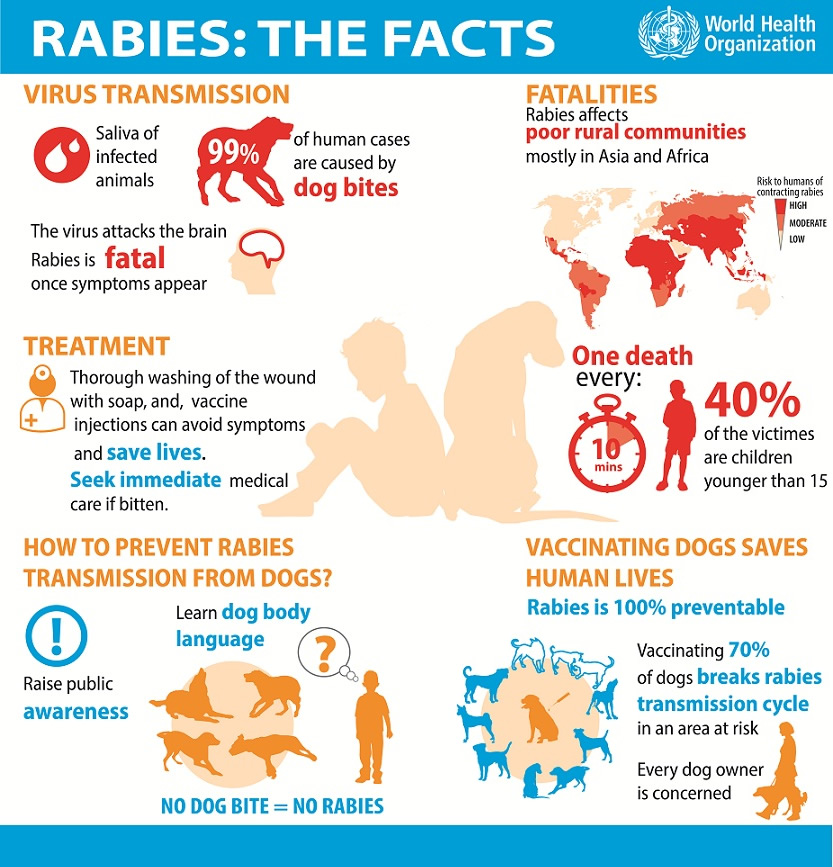
The rabies virus is found in the saliva of a sick animal. Infection occurs when a person and a sick animal come into contact: bite, saliva, scratches and other damage to the skin and mucous membranes, and the aerosol transmission of the virus can also be. People injured and salivated by sick animals or suspicious animals are at risk of contracting rabies. Such persons must immediately appoint and begin a course of therapeutic and prophylactic vaccinations.
The animal is subject to isolation for 10 days. The material of the deceased animal is delivered to a special laboratory. Household items, territory that may be contaminated, the remains of a dead animal are disinfected. Specific treatment of the affected person should be started as early as possible, until the results of the laboratory examination of the deceased animal are obtained. Otherwise, precious time will be wasted.
The only protection against this formidable deadly disease is timely vaccination with the rabies vaccine prescribed by a doctor.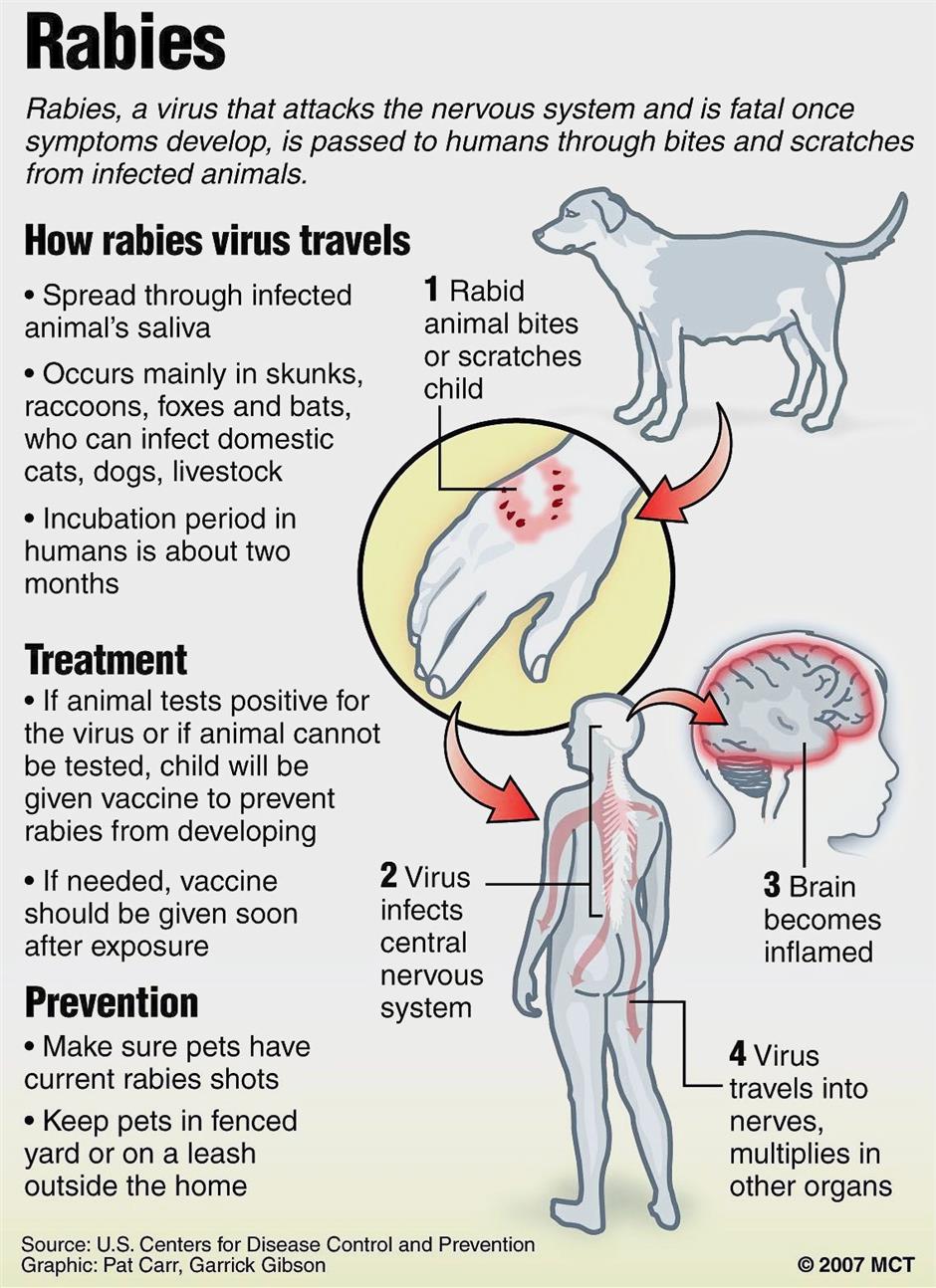 The injured person should contact a medical facility immediately. The sooner a course of vaccinations is prescribed, the more chances a person will have to survive, because rabies is an absolutely fatal disease and there is no cure for it. When a virus enters human organizations, it immediately enters the brain and spinal cord through the nerve endings. Therefore, bites and injuries in the area of \u200b\u200bthe hands and in the head area are very dangerous.
The injured person should contact a medical facility immediately. The sooner a course of vaccinations is prescribed, the more chances a person will have to survive, because rabies is an absolutely fatal disease and there is no cure for it. When a virus enters human organizations, it immediately enters the brain and spinal cord through the nerve endings. Therefore, bites and injuries in the area of \u200b\u200bthe hands and in the head area are very dangerous.
The virus, multiplying, destroys the brain, turning it into a jelly-like mass, and the person dies in agony. The latent period of the disease can last from 7 days to 2 years.
In response to vaccination, a person begins to develop immunity, which prevents the development and reproduction of the virus in the body. With late treatment, a person’s immunity does not have time to develop, which leads to death.
If an animal has bitten or scratched a person, or there has been contact with the saliva of a suspicious animal, immediately wash the damaged surface very abundantly with soap for 15 minutes, rinse the wound thoroughly under running water to wash the virus off the skin, treat the wound with hydrogen peroxide, treat the edges of the wound with 5% tincture of iodine and immediately consult a doctor. An animal that attacked a person should be observed for 10 days.
An animal that attacked a person should be observed for 10 days.
When carrying out immunization courses against rabies, it is impossible not to comply with the terms and schedule of vaccinations, otherwise the immunity is insufficient (not strained). For the same reason, you should not take any alcohol during the entire course of vaccinations.
A characteristic sign of an animal’s disease is considered to be a change in the animal’s behavior: wild animals are not afraid of people, enter settlements, become affectionate, allow themselves to be stroked, domestic animals become aggressive, attack, bite, scratch their owners, other animals, salivation, hydrophobia (with convulsions may appear in the form of water in animals), paralysis develops.
Be sure to pay attention to these changes in behavior, as many people are not afraid of pets and can be infected with rabies. Therefore, it is necessary to vaccinate your pets against rabies every year, to prevent pets from communicating with stray, wild animals.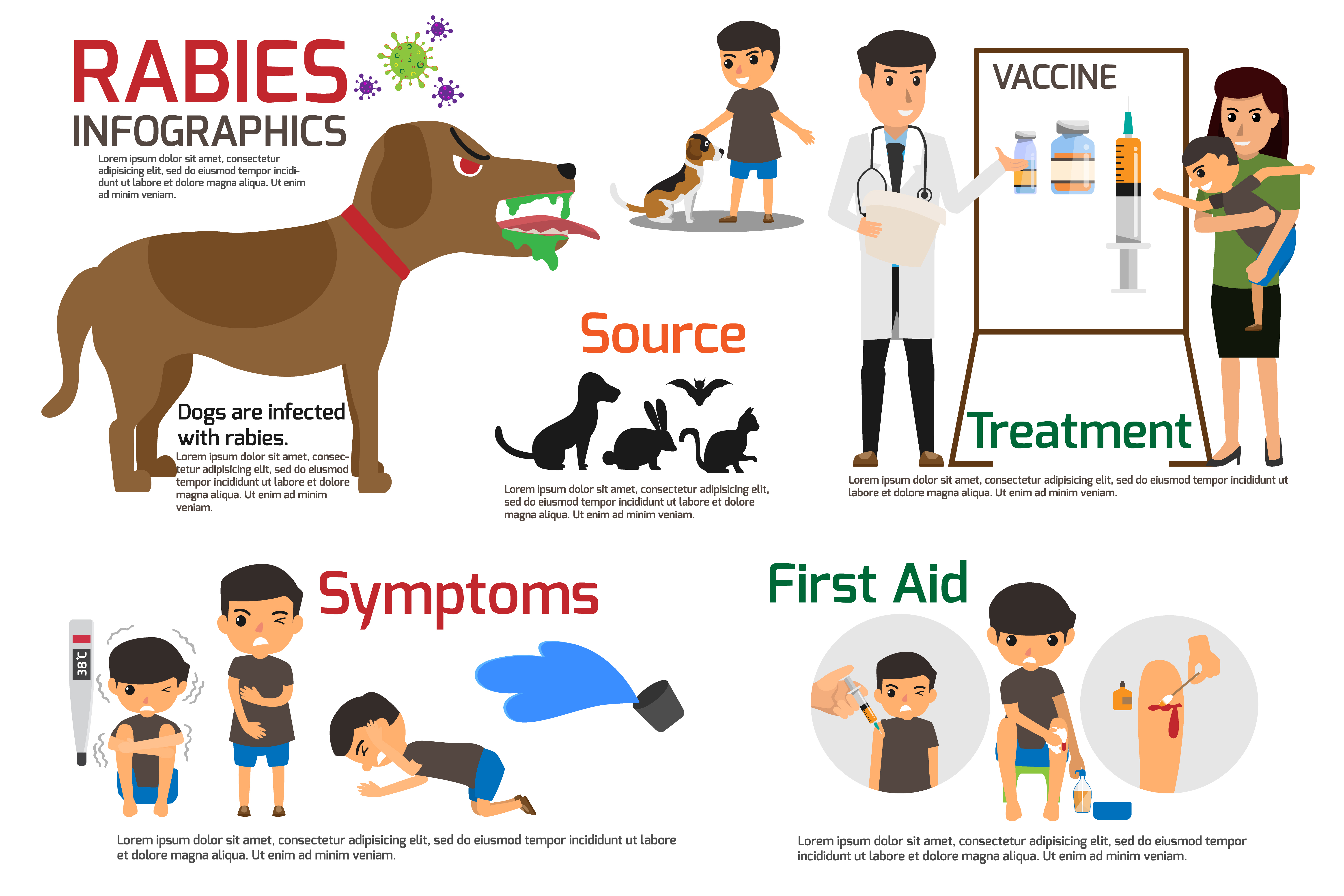

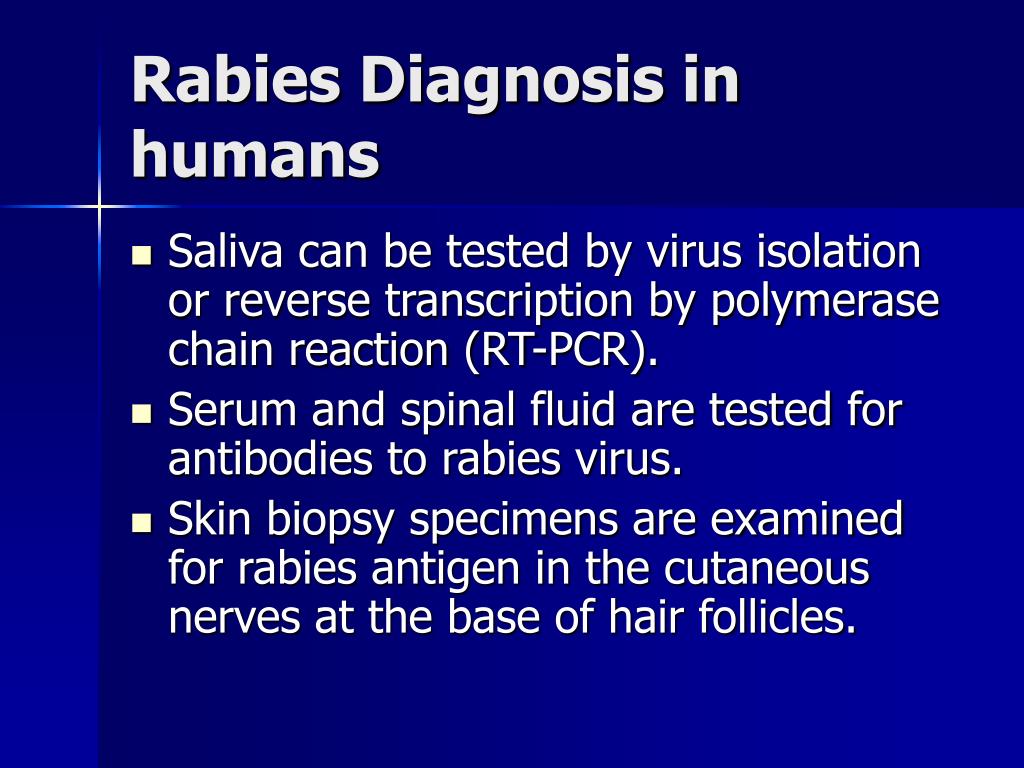
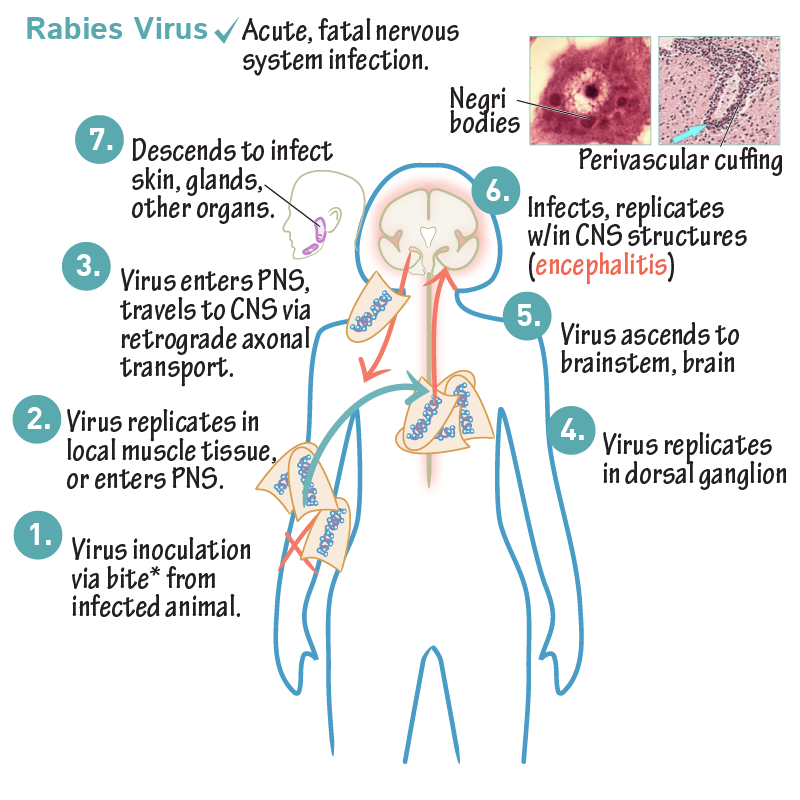 Heliyon. 2018 Sep;4(9):e00754. [PMC free article: PMC6129686] [PubMed: 30211329]
Heliyon. 2018 Sep;4(9):e00754. [PMC free article: PMC6129686] [PubMed: 30211329] Prev Vet Med. 2018 Oct 01;158:65-70. [PubMed: 30220397]
Prev Vet Med. 2018 Oct 01;158:65-70. [PubMed: 30220397] PLoS One. 2018;13(7):e0200873. [PMC free article: PMC6062032] [PubMed: 30048466]
PLoS One. 2018;13(7):e0200873. [PMC free article: PMC6062032] [PubMed: 30048466]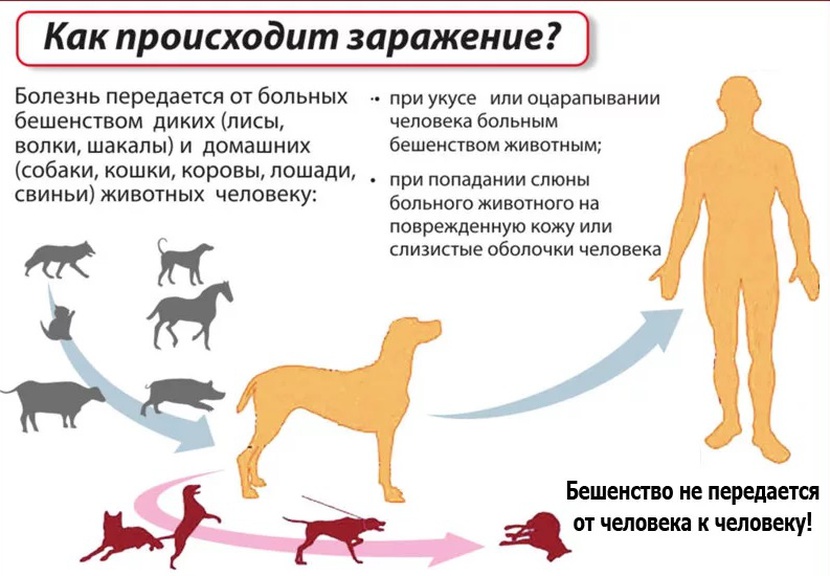 Caring for a patient with rabies: implications of the Milwaukee protocol for infection control and public health measures. J Hosp Infect. 2017 Aug;96(4):385-391. [PubMed: 28559126]
Caring for a patient with rabies: implications of the Milwaukee protocol for infection control and public health measures. J Hosp Infect. 2017 Aug;96(4):385-391. [PubMed: 28559126] PLoS One. 2018;13(2):e0192313. [PMC free article: PMC5821350] [PubMed: 29466403]
PLoS One. 2018;13(2):e0192313. [PMC free article: PMC5821350] [PubMed: 29466403]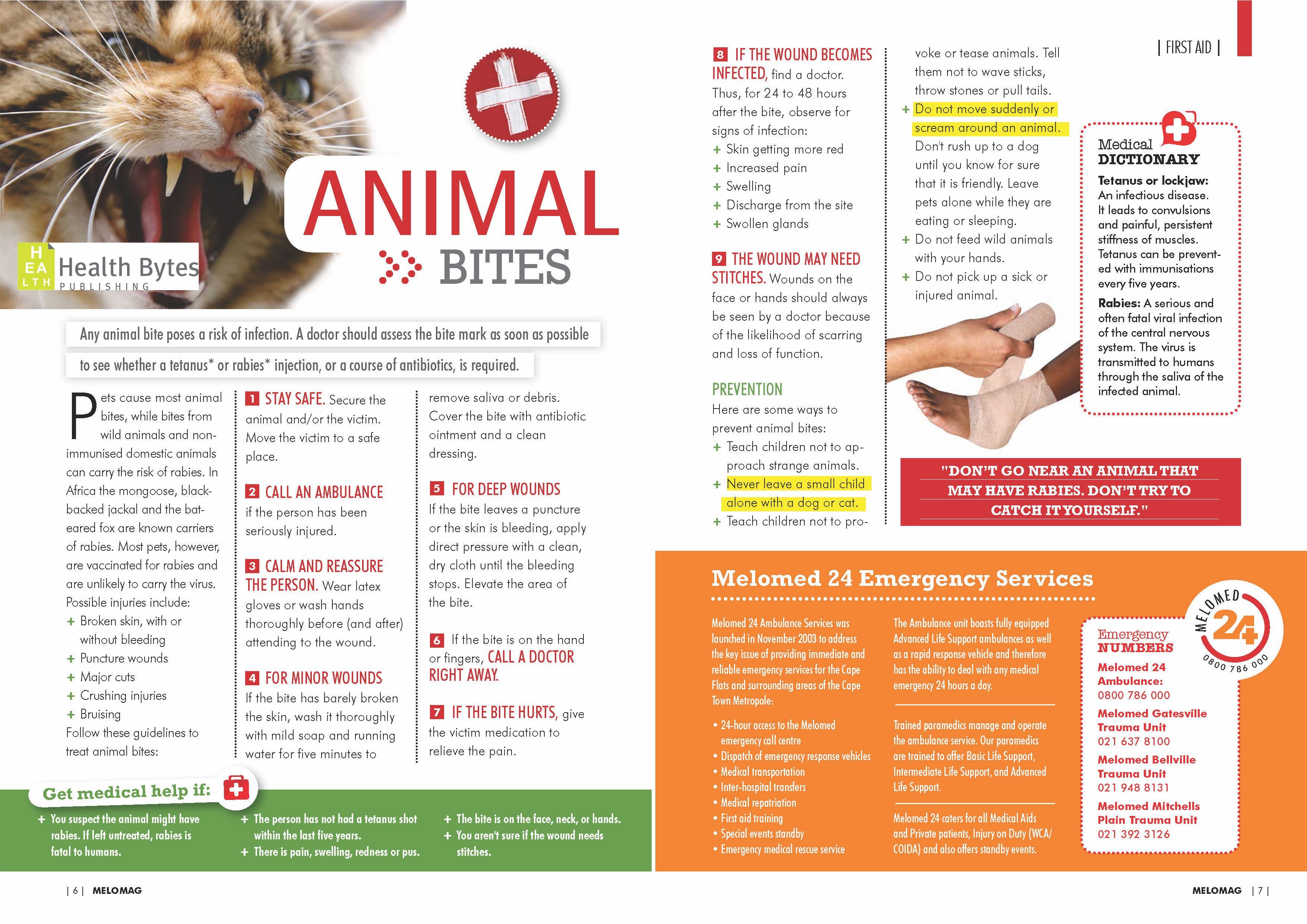
 S.
S.
 Flush the wound thoroughly with water.
Flush the wound thoroughly with water.
 So, for example, cases of the development of rabies in people who process the skins of sick foxes are known.
So, for example, cases of the development of rabies in people who process the skins of sick foxes are known. Vaccination against rabies is free of charge, regardless of the presence of a compulsory health insurance policy.
Vaccination against rabies is free of charge, regardless of the presence of a compulsory health insurance policy.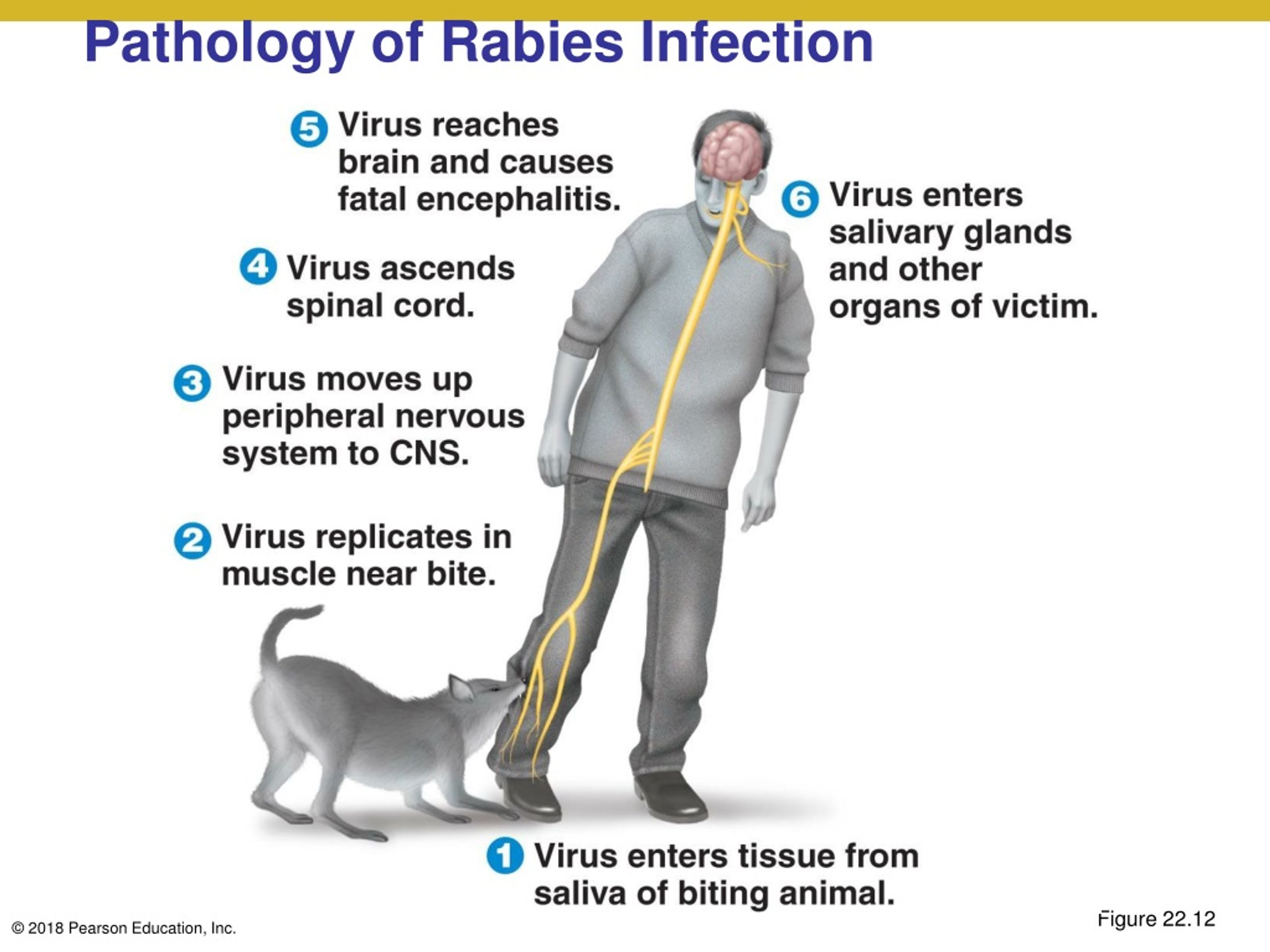 An aggressive animal is especially dangerous as it can infect other animals or people.
An aggressive animal is especially dangerous as it can infect other animals or people. Explain that if a child is accidentally bitten or scratched by a stray animal, they should report it to a parent as soon as possible.
Explain that if a child is accidentally bitten or scratched by a stray animal, they should report it to a parent as soon as possible.